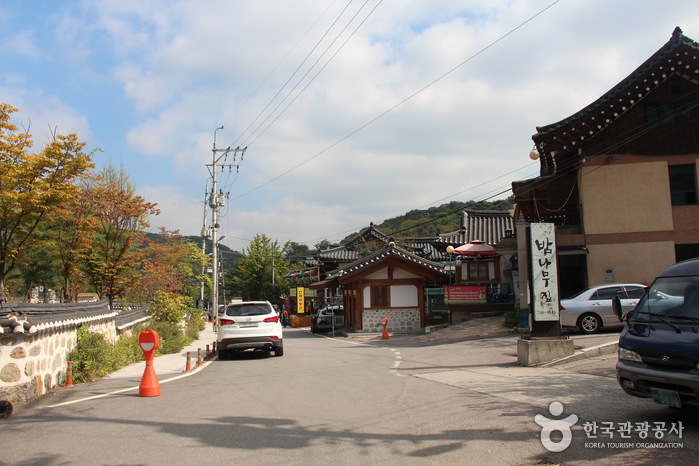Gyeonggi Janggyeongsa Temple (장경사(경기))
17.9Km 2025-01-14
676, Namhansanseong-ro, Gwangju-si, Gyeonggi-do
+82-31-743-6548
Janggyeongsa Temple is located in Namhansanseong Fortress. Namhansanseong Fortress, which protected Seoul along with Bukhansanseong Fortress, was built at the same time as Janggyeongsa Temple in 1638, during the 16th year of King Injo. Warrior monks from all eight provinces throughout the country helped with the construction. Janggyeongsa Temple is the only remaining temple among nine such temples where military groups made up of monks stayed for trainings.
Olive Young - Hanam Sinjang Branch [Tax Refund Shop] (올리브영 하남신장점)
18.0Km 2024-06-27
127-1, Sinjang-ro, Hanam-si, Gyeonggi-do
-
E-Mart - Hanam Branch [Tax Refund Shop] (이마트 하남)
18.4Km 2024-04-22
70, Deokpungseo-ro, Hanam-si, Gyeonggi-do
-
Sojindam (소진담)
18.6Km 2024-02-08
178-42 Misadong-ro 40beon-gil, Hanam-si, Gyeonggi-do
Sojindam is a café offering a panoramic view from its rooftop. It features outdoor seating on the first floor, indoor seating on the second floor, and a rooftop on the third floor, each providing a unique atmosphere. One of its signature items is the Sojindam latte, a chocolate ice cream latte. The desserts, particularly the cakes, are quite popular. Conveniently located near Misagyeongjeong Park, a favored spot for autumn pink muhly grass, the café is set in a picturesque location ideal for photography.
Traditional Food Town around Namhansanseong Fortress (남한산성 전통음식마을)
18.7Km 2021-03-17
731, Namhansanseong-ro, Gwangju-si, Gyeonggi-do
+82-31-762-3010
The Traditional Food Town around Namhansanseong Fortress has many restaurants offering rice, dotorimuk (acorn jelly salad), tojongdak (whole chicken) dishes, and other traditional dishes. The area embraces almost 300 years of Korean history and the restaurants were built in traditional hanok-style buildings around Namhansanseong Fortress, a military stronghold from the Joseon dynasty.
Namhansanseong Provincial Park [UNESCO World Heritage] (남한산성도립공원 [유네스코 세계문화유산])
18.7Km 2024-02-29
731 Namhansanseong-ro, Namhansanseong-myeon, Gwangju-si, Gyeonggi-do
+82-31-746-1088
Namhansanseong was a fortress that protected the southern approaches to the capital during the Baekje kingdom (18 B.C. – 660 A.D.) and the Joseon dynasty (1392-1897). During the Qing invasion of Joseon in 1636, King Injo of Joseon (reigned 1623-1649) sought refuge here and constructed Haenggung, a temporary palace. Subsequently, it became the administrative center of the Gwangju region, and today, it is a site where many cultural properties are preserved.
Lotte Mart - Maseok Branch [Tax Refund Shop] (롯데마트 마석점)
19.2Km 2024-04-22
1992, Gyeongchun-ro, Hwado-eup, Namyangju-si, Gyeonggi-do
-
Lotte Himart - Deokso Lotte Mart Branch [Tax Refund Shop] (롯데하이마트 덕소롯데마트점)
19.2Km 2024-04-22
33, Wolmuncheon-ro, Wabu-eup, Namyangju-si, Gyeonggi-do
-
Lotte Mart - Deokso Branch [Tax Refund Shop] (롯데마트 덕소점)
19.2Km 2024-04-22
33, Wolmuncheon-ro, Wabu-eup, Namyangju-si, Gyeonggi-do
-
Namhansanseong Trail (남한산성 탐방로)
19.2Km 2024-02-20
Sanseong-ri, Namhansanseong-myeon, Gwangju-si, Gyeonggi-do
Namhansanseong Trail is a historical-themed path designed to provide an experiential journey through the Namhansanseong Fortress, a UNESCO World Heritage site. This lengthy elliptical fortress is built on rugged terrain at an elevation of 500 meters, with walls spanning a circumference of 12.4 kilometers. Offering a total of five routes, the trail presents breathtaking scenery and adds charm with pathways that closely follow the fortress walls.

![E-Mart - Hanam Branch [Tax Refund Shop] (이마트 하남)](http://tong.visitkorea.or.kr/cms/resource/00/2888500_image2_1.jpg)

![Namhansanseong Provincial Park [UNESCO World Heritage] (남한산성도립공원 [유네스코 세계문화유산])](http://tong.visitkorea.or.kr/cms/resource/56/2612856_image2_1.jpg)
![Lotte Mart - Maseok Branch [Tax Refund Shop] (롯데마트 마석점)](http://tong.visitkorea.or.kr/cms/resource/51/2881351_image2_1.jpg)
![Lotte Himart - Deokso Lotte Mart Branch [Tax Refund Shop] (롯데하이마트 덕소롯데마트점)](http://tong.visitkorea.or.kr/cms/resource/96/2890296_image2_1.jpg)
![Lotte Mart - Deokso Branch [Tax Refund Shop] (롯데마트 덕소점)](http://tong.visitkorea.or.kr/cms/resource/45/2887945_image2_1.jpg)
 English
English
 한국어
한국어 日本語
日本語 中文(简体)
中文(简体) Deutsch
Deutsch Français
Français Español
Español Русский
Русский